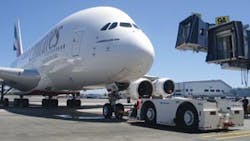Conventional or Towbarless Tractors?
By Juan Martin, Towbarless Tractor Engineering Manager & Jeff Horst, Conventional Tractor Engineering Manager
What type of tractor should I buy, conventional or towbarless? This is a common question that JBT AeroTech is asked by our customers on a frequent basis. Being that we manufacture both types of tractors, we are in the position to give our customers a fair assessment on the pros and cons of each type. The most important factors that we tell our customers is to consider the total cost of ownership pertaining to safety, efficiency, performance and maintenance costs.
Addressing Safety
There are several areas of safety that need to be addressed when choosing the right tractor. These include visibility, braking, back up systems and ground crew transport. The design of the cab and tractor body should be done with the premise of minimizing all “blind spots” in order to give the operator maximum visibility from the driver’s seat. The design of our tractor bodies has smooth top surfaces and sloped engine compartments for all-around good visibility. The towbarless tractors offer better overall visibility, because of the lower body design and the swiveled operator seat that allow the driver to look straight ahead during aircraft pickup and driving.
For braking, the conventional tractor uses a centralized hydraulic braking system with automotive type shoe or disc brakes, while towbarless tractors use hydrostatic drive with dynamic braking. With dynamic braking, the tractor does not coast when the operator removes his/her foot from the accelerator, rather you “brake down” slowly coming to a smoother stop. When slamming on the brakes the result is the same, both hydraulic and dynamic brakes will lock up the tractor and bring the aircraft to a halting stop, a practice only recommended during emergencies.
Another element of braking safety to be reckoned with is jackknifing the aircraft when coming to a stop or operating on a slippery surface. Conventional tractors always run the risk of slipping on ice or snow when the tractor is not in a straight line with the center of the aircraft nose wheel. The farther the tractor is off center, the greater chance of jackknifing if the aircraft has to be stopped abruptly on a slippery
surface. Our Expediter towbarless tractors have a patented design with an over steering alarm system that keeps the tractor’s wheels straight when sensors feel the tractor starting to slip, thus avoiding any chance of jackknifing. This is a very important safety feature, especially during high-speed towing.
Ground crew safety is a concern when wing walkers are used. Expediters offer seating for three, the driver and two crew members, who can ride back to the gate area in the safety of the tractor. Our conventional tractors, like most models, offer only two seats, which means that one wing walker needs to be picked up by another vehicle or walk across the tarmac.
Customer Requirements
For efficiency, we found that it depends on the customer’s operational requirements. For push outs, conventional tractors are most efficient when a customer services one aircraft type. The efficiency diminishes with more types of aircraft serviced due to different tow bars required. Another area where towbarless tractors excel in operational requirements is they offer a much smaller turning radius, which is a must in tight turning areas.
The airport operation where towbarless tractors excel the most over conventional tractors is maintenance towing and aircraft spotting. The key element in these operations is the ability to maintain the same speed as taxiing aircraft so that the towing operation does not interfere with the movement of aircraft on the taxiway. Conventional tractors are unable to maintain such speeds because of safety issues with the towbar and engine horsepower constraints from the tractor’s design. The first towbarless tractors introduced in the 1980s were originally designed to tow live aircraft from the airport terminal to the edge of the runway as a way for the airlines to reduce fuel costs. This type of operation never took off, but led the way for towbarless tractors to excel in high-speed maintenance towing operations.
Today, airlines have realized savings of thousands of dollars in operating costs when using towbarless tractors to replace aircraft taxiing to move aircraft on taxiways at high speed during maintenance towing and spotting. Huge savings come from lower aircraft engine cycle times and hours, aircraft fuel savings and manpower. There are reports that show the savings actually equaled the tractor’s purchase price in one year.
Maintenance Factors
When it comes to the cost to maintain the units, a conventional tractor’s simple design and fewer operating components is less costly to maintain in comparison to the towbarless tractor. The towbarless tractors also require technicians with greater knowledge of hydraulics and electronics to maintain the nose wheel pick up system.
From a global perspective, we have observed that towbarless tractors are most popular in Western Europe where they are used for both push outs and high-speed towing. In North America, Asia and the Middle East, they are used primarily for maintenance towing. Africa and Latin America have stayed with conventional tractors.
It is JBT AeroTech’s recommendation, that when deciding on a conventional or towbarless tractor, the decision should not be based upon the unit selling price but on which type of tractor offers the best safety, performance and efficiency for your operation.
